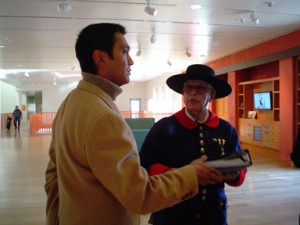The New Mexico History Museum today played host to a contingent of accurate-to-the-period-dressed representatives of the Sons of the American Revolution. The group arrived eager to see the new exhibit The Threads of Memory: Spain and the United States (El Hilo de la Memoria: España y los Estados Unidos), in particular for its final section’s depiction of Spain’s role in helping the revolutionaries win their war against Great Britain.
That they did so in period style enthralled — and sometimes perplexed — other museum visitors, many of whom did the first thing any modern American thinks of in such situation: Pull out the cell phone and snap a pic.

George C. Garcia, Charles Martinez y Vigil and Gene Tomlinson
Why did they pick today for a visit? With the group’s national president, David Sympson, in town, the time seemed right to see firsthand some of the documents that form their heritage. So, after lunch at the Osteria restaurant, they strolled over to the museum, having stashed their 9-foot lances in a room at the eatery.
“(Deputy Director) John McCarthy told us beforehand, `Don’t bring any weapons,'” said SAR New Mexico President Gene Tomlinson.
He was joined by the Santa Fe Chapter president, Charles Martinez y Vigil, and George C. Garcia. With their brass-buttoned knickers and Zorro-style hats, they were authentic from their 1780 Santa Fe Presidio garb down to their personal DNA. Tomlinson claims an ancestor who fought in the American Revolution; Martinez y Vigil and Garcia claim ancestors who contributed to Spain’s bankrolling of war against the Redcoats.
“If we were to walk in the front doors of the Palace of the Governors,” Tomlinson said, “these uniforms probably haven’t been worn there since 1790.”

Curator Josef Diaz (left) with George C. Garcia
A primary goal of Threads of Memory is to deepen Americans’ knowledge of just how much muscle Spain exerted in the Americas in the centuries that are often taught from an East Coast perspective. From the earliest explorers in the 1500s, through the establishment of Santa Fe in 1610, the colonization of today’s New Mexico, Florida, Texas and California, and the multi-nation efforts in the American Revolution, Spain has made Americans far more Spanish than many believe they are.
That’s also a goal of the Sons of the American Revolution, which has been reaching out to descendants of all Spanish soldiers to research their lineage and apply for society membership. From the NM Patriot website:
When the American colonies waged a war for independence against England, King Carlos III of Spain sought opportunity to regain land Spain lost to England at the end of the Seven Years War in 1773. Spain agreed to join France as an ally and beginning in 1776, covertly shipped arms, munitions, cattle, uniforms, medicine, blankets, and money to the American colonies using France as the go between. Spain declared war on England in June 1779
In March of 1780, Carlos III decreed that to sustain the war against England, “his vassals in America” were to contribute a one-time donativo (donation) of one peso (approximately $30 by year 2002 standard) per Indian and other castes and two pesos per Spaniard and noble. Collectors (such as alcalde mayores or military commanders) went to towns and pueblos in the New World and collected one peso per Indian over 18 years old and other castes, and two pesos from each Spaniard. Donativos were collected from soldiers and citizens throughout Cuba and Spain’s hard-pressed North American colonies, including the provinces of California, New Mexico, and Texas.
–Robert H. Thonhoff, The Vital Contributions of Spain in the Winning of the American Revolution: An Essay on a Forgotten Chapter in the History of the American Revolution, 2000, (2), self published
The SAR recognizes a variety of ancestral involvement in the war as worthy of membership: service in the Spanish military, the militia, or as Indian auxiliaries; donating money to defray expenses of the war; Spanish cowboys (in Texas) who drove cattle to feed the American colonial troops; and mission priests who led public prayers on behalf of Spain’s support of the American Revolution.
Upon entering the exhibit, the SAR contingent proved themselves true students of history by becoming engrossed not only in the exhibition’s final section, but by creeping through its length, magnifying glasses in hand. We were delighted to welcome them — and just as delighted to give our unsuspecting other visitors an interesting dinner-table tale to share later.
